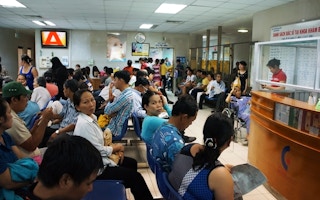Malaria and other tropical diseases continue to pose a substantial risk in Southeast Asia, with about 30 million cases and 450,000 deaths from malaria alone in 2013, according to the World Health Organization.
To continue reading, subscribe to Eco‑Business.
There's something for everyone. We offer a range of subscription plans.
- Access our stories and receive our Insights Weekly newsletter with the free EB Member plan.
- Unlock unlimited access to our content and archive with EB Circle.
- Publish your content with EB Premium.
The economic and health costs of these diseases is substantial, especially for countries with relatively low per capita public health expenditure, such as Indonesia, where spending amounts to just 2.7 per cent of the country’s GDP.
Rapid and dynamic changes in the region including population growth and movement, along with booming urbanization, have contributed to the complexity of combating the spread of diseases.
Now the region is faced with an even greater challenge: climate change. A rise in the frequency and extremity of storms, floods, droughts and heat waves, exacerbates the risks posed by vector-borne diseases. Temperature changes affect both the distribution of the vector and the effectiveness of transmission through the vector, and worryingly, extreme climate variability has the potential to precipitate concurrent multiple disease epidemics.
Health services, and other parts of the economy, need to respond and adapt to these new realities. However, the resources needed to address tropical diseases like malaria are limited.
“
Climate change is upon us, so the time for innovation and action to prevent serious widespread epidemics in future is now.
The message then is that public health systems need to find ways to make both prevention and treatment of these diseases more effective and efficient, without substantial new public funds. That will require doing more to tap the support of the private sector, community-based-organizations, and the communities themselves.
Successful adaptation to climate change requires well thought out public health strategies, and accurate surveillance. Early warning systems will need to be developed and integrated into public health strategies to anticipate any potential disease outbreaks arising from extreme climate events. Better urban planning is also needed to reduce risks.
Intervention areas should include public education, vector-borne disease surveillance, outbreak management, vector management, disaster preparedness and response, flood and disaster risk mapping, proper laboratories, better diagnosis and reporting systems, and access to health care for vulnerable population subgroups.
All of these measures require substantial funding which can’t be found in existing public health sector budgets alone. That means policymakers will need to come up with new ideas like public-private-partnerships and innovative financing mechanisms.
Climate change is upon us, so the time for innovation and action to prevent serious widespread epidemics in future is now.
Rooswanti Soeharno is a Social Sector Officer in ADB’s Indonesia Resident Mission. This post originally appeared on the Asian Development Bank blog.











